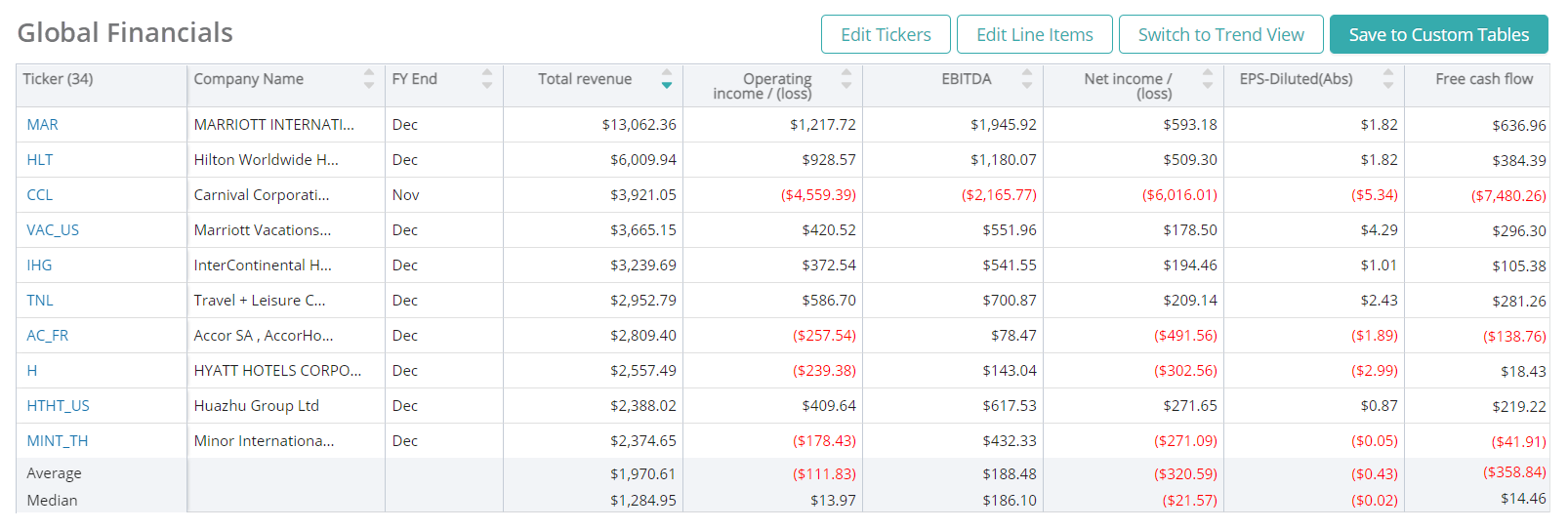A room is a part or division of a building enclosed by walls, floor, and ceiling, which is rented by hotel guests for accommodation or lodging on a short-term basis in exchange for money.
Key performance indicators (KPIs) are the most important business metrics for a particular industry. When understanding market expectations for hotels and timeshares, whether at a company or industry level, here are some of the hotel KPIs to consider:
Visible Alpha’s Standardized Industry Metrics
To understand market expectations for the hotel industry, a key information source is sell-side analyst estimate and consensus forecast data. The buy side, sell side and public companies leverage this type of data to conduct competitive analysis, a type of analysis conducted by professional analysts that involves comparing standardized metrics of one company with those of similar companies. Because companies report metrics differently – and sometimes report on different metrics altogether – standardizing the key metrics for each company can be a cumbersome process.
Visible Alpha Insights includes analyst data, company data and industry data at level of granularity unparalleled in the market. Our industry data – Standardized Industry Metrics – enables market participants to quantify and compare market expectations for companies across 150+ industries.
Data as of January 2023
Industry KPI Terms & Definitions
Owned Hotel
A privately-owned and operated hotel has proprietary ownership in the company’s name, though investors or others may have a financial interest in the hotel.
Leased Hotel
A leased hotel is owned by a third-party but has leased the physical building of the hotel to the company for a predetermined period.
Managed Hotel
A managed hotel is owned by a third-party but has signed an agreement with another hotel brand to manage the hotel operations.
Franchisee Hotel
A franchisee hotel is owned by a third-party, but to use the brand name, the owner pays an upfront fee and ongoing royalties.
Rooms
A room is a part or division of a building enclosed by walls, floor, and ceiling, which is rented by hotel guests for accommodation or lodging on a short-term basis in exchange for money.
Room Nights
Room nights are the number of rooms available multiplied by the number of days in a given period.
Number of Days
The number of days in an analyzing period.
Occupancy Rate
The occupancy rate is the percentage of available rooms being sold for a certain period. It is computed as the total number of rooms sold divided by the total number of rooms available. Occupancy rate measures the utilization of a property’s available capacity.
Average Daily Rate (ADR)
Average daily rate (ADR) is the average price or rate at which each hotel room was sold for a specific day. ADR is also a financial indicator to measure how successful the performance of a hotel is compared to other hotels with similar offerings, such as hotel size, amenities, services, location and the hotel’s historical trend.
Revenue Per Available Room (RevPar)
Revenue per available room (RevPAR) is a metric used in the hotel industry to measure hotel performance. It is calculated by multiplying a hotel’s occupancy rate by its average daily rate (ADR). RevPAR is also derived by dividing a hotel’s total room revenue by the total number of available rooms.
Royalty Rate
A royalty rate is a legally-binding payment made to a company for the ongoing use of the company’s brand. Royalties are revenue generators specifically designed to compensate a company for allowing franchisees to use its brand name. Royalty payments typically constitute a percentage of the gross or net revenues obtained from using the owner’s property, referred to as royalty rate.
System-Wide Sales
System-wide sales is the total sales generated at all the hotels of a company. It includes total sales held at company-owned, leased, managed and franchisee hotels. System-wide sales are different from the company’s net revenue. Net revenue includes sales from owned and leased hotels, franchise fees based on a percentage of franchisee system-wide sales, and base management fees and incentive management fees, both as an agreed percentage of managed system-wide sales.
Tour Flow
Tour flow is the number of sales presentations given at sales locations in a given period.
Volume Per Guest (VPG)
Volume per guest (VPG) is calculated by dividing consolidated vacation ownership contract sales – excluding fractional sales, telesales, resales, joint venture sales and other sales that are not attributed to a tour at a sales location – with tour flow. It measures the effectiveness of the sales process.
Download this guide as an ebook today:
Guide to Hotels KPIs for Investment Professionals
This guide highlights the key performance indicators for the heotels industry and where investors should look to find an investment edge, including:
- Hotels Industry Business Model & Diagram
- Key Hotels Metrics PLUS Visible Alpha’s Standardized Industry Metrics
- Available Comp Tables
- Industry KPI Terms & Definitions










